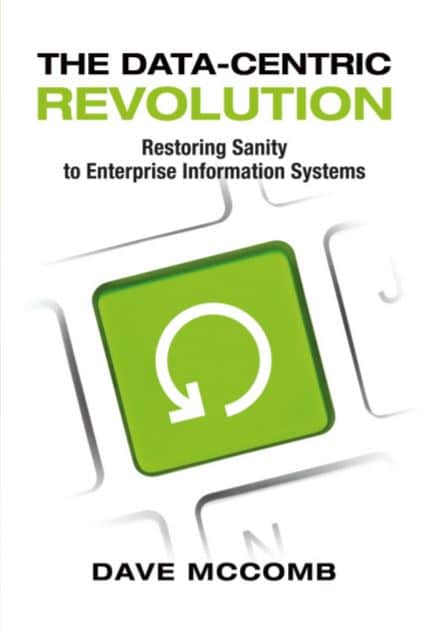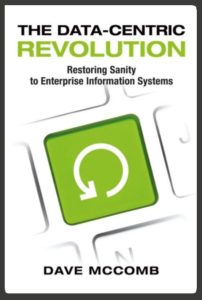
Below is an excerpt and downloadable copy of the “Chapter 2: What is Data-Centric?”
CHAPTER 2
What is Data-Centric?
Our position is:
A data-centric enterprise is one where all application functionality is based on a single, simple, extensible data model.
First, let’s make sure we distinguish this from the status quo, which we can describe as an application-centric mindset. Very few large enterprises have a single data model. They have one data model per application, and they have thousands of applications (including those they bought and those they built). These models are not simple. In every case we examined, application data models are at least 10 times more complex than they need to be, and the sum total of all application data models is at least 100-1000 times more complex than necessary.
Our measure of complexity is the sum total of all the items in the schema that developers and users must learn in order to master a system. In relational technology this would be the number of classes plus the number of all attributes (columns). In object-oriented systems, it is the number of classes plus the number of attributes. In an XML or json based system it is the number of unique elements and/or keys.
The number of items in the schema directly drives the number of lines of application code that must be written and tested. It also drives the complexity for the end user, as each item, eventually surfaces in forms or reports and the user must master what these mean and how the relate to each other to use the system.
Very few organizations have applications based on an extensible model. Most data models are very rigid. This is why we call them “structured data.” We define the structure, typically in a conceptual model, and then convert that structure to a logical model and finally a physical (database specific) model. All code is written to the model. As a result, extending the model is a big deal. You go back to the conceptual model, make the change, then do a bunch of impact analysis to figure out how much code must change.
An extensible model, by contrast is one that is designed and implemented such that changes can be added to the model even while the application is in use. Later in this book and especially in the two companion books we get into a lot more detail on the techniques that need to be in place to make this possible.
In the data-centric world we are talking about a data model that is primarily about what the data means (that is, the semantics). It is only secondarily, and sometimes locally, about the structure, constraints, and validation to be performed on the data.
Many people think that a model of meaning is “merely” a conceptual model that must be translated into a “logical” model, and finally into a “physical” model, before it can be implemented. Many people think a conceptual model lacks the requisite detail and/or fidelity to support implementation. What we have found over the last decade of implementing these systems is that done well, the semantic (conceptual) data model can be put directly into production. And that it contains all the requisite detail to support the business requirements.
And let’s be clear, being data-centric is a matter of degree. It is not binary. A firm is data-centric to the extent (or to the percentage) its application landscape adheres to this goal.
Data-Centric vs. Data-Driven
Many firms claim to be, and many firms are, “data-driven.” This is not quite the same thing as data-centric. “Data-driven” refers more to the place of data in decision processes. A non-data-driven company relies on human judgement as the justification for decisions. A data-driven company relies on evidence from data.
Data-driven is not the opposite of data-centric. In fact, they are quite compatible, but merely being data-driven does not ensure that you are data-centric. You could drive all your decisions from data sets and still have thousands of non-integrated data sets.
Our position is that data-driven is a valid aspiration, though data-driven does not imply data-centric. Data-driven would benefit greatly from being data-centric as the simplicity and ease of integration make being data-driven easier and more effective.
We Need our Applications to be Ephemeral
The first corollary to the data-centric position is that applications are ephemeral, and data is the important and enduring asset. Again, this is the opposite of the current status quo. In traditional development, every time you implement a new application, you convert the data to the new applications representation. These application systems are very large capital projects. This causes people to think of them like more traditional capital projects (factories, office buildings, and the like). When you invest $100 Million in a new ERP or CRM system, you are not inclined to think of it as throwaway. But you should. Well, really you shouldn’t be spending that kind of money on application systems, but given that you already have, it is time to reframe this as sunk cost.
One of the ways application systems have become entrenched is through the application’s relation to the data it manages. The application becomes the gatekeeper to the data. The data is a second-class citizen, and the application is the main thing. In data-centric, the data is permanent and enduring, and applications can come and go.
Data-Centric is Designed with Data Sharing in Mind
The second corollary to the data-centric position is default sharing. The default position for application-centric systems is to assume local self-sufficiency. Most relational database systems base their integrity management on having required foreign key constraints. That is, an ordering system requires that all orders be from valid customers. The way they manage this is to have a local table of valid customers. This is not sharing information. This is local hoarding, made possible by copying customer data from somewhere else. And this copying process is an ongoing systems integration tax. If they were really sharing information, they would just refer to the customers as they existed in another system. Some API-based systems get part of the way there, but there is still tight coupling between the ordering system and the customer system that is hosting the API. This is an improvement but hardly the end game.
As we will see later in this book, it is now possible to have a single instantiation of each of your key data types—not a “golden source” that is copied and restructured to the various application consumers, but a single copy that can be used in place.
Is Data-Centric Even Possible?
Most experienced developers, after reading the above, will explain to you why this is impossible. Based on their experience, it is impossible. Most of them have grown up with traditional development approaches. They have learned how to build traditional standalone applications. They know how applications based on relational systems work. They will use this experience to explain to you why this is impossible. They will tell you they tried this before, and it didn’t work.
Further, they have no idea how a much simpler model could recreate all the distinctions needed in a complex business application. There is no such thing as an extensible data model in traditional practice.
You need to be sympathetic and recognize that based on their experience, extensive though it might be, they are right. As far as they are concerned, it is impossible.
But someone’s opinion that something is impossible is not the same as it not being possible. In the late 1400s, most Europeans thought that the world was flat and sailing west to get to the far east was futile. In a similar vein, in 1900 most people were convinced that heavier than air flight was impossible.
The advantage we have relative to the pre-Columbians, and the pre-Wrights is that we are already post-Columbus and post-Wrights. These ideas are both theoretically correct and have already been proved.
The Data-Centric Vision
To fix your wagon to something like this, we need to make a few aspects of the end game much clearer. We earlier said the core of this was the idea of a single, simple, extensible data model. Let’s drill in on this a bit deeper.
Click here to download the entire chapter.
Use the code: SemanticArts for a a 20% discount off of Technicspub.com
 to make use of the data they have.
to make use of the data they have.
 a rallying point around which to gather and show our colors to the world. They are a way of showing membership in a group, or providing a warning. Which is why it is so unfortunate when we find flags in a data management system, because they are reduced to saying nothing. Let me explain.
a rallying point around which to gather and show our colors to the world. They are a way of showing membership in a group, or providing a warning. Which is why it is so unfortunate when we find flags in a data management system, because they are reduced to saying nothing. Let me explain. months. Both exercises reminded me that Data-Centric is not a simple technology upgrade. It’s going to take a great deal more to shift the status quo.
months. Both exercises reminded me that Data-Centric is not a simple technology upgrade. It’s going to take a great deal more to shift the status quo. PowerPoint slides that served to anchor, but it was much more a continual co-creation of a shared artifact.
PowerPoint slides that served to anchor, but it was much more a continual co-creation of a shared artifact.
 You may be wondering what some of our Data-Centric Conference panel topics will actually look like, what the discussion will entail. This article from Forbes is an interesting take on knowledge graphs and is just the kind of thing we’ll be discussing at the Data-Centric Conference.
You may be wondering what some of our Data-Centric Conference panel topics will actually look like, what the discussion will entail. This article from Forbes is an interesting take on knowledge graphs and is just the kind of thing we’ll be discussing at the Data-Centric Conference. software-as-a-service are increasingly well established. Open source software is popular and readily available, and custom app development has become fairly straightforward.
software-as-a-service are increasingly well established. Open source software is popular and readily available, and custom app development has become fairly straightforward.